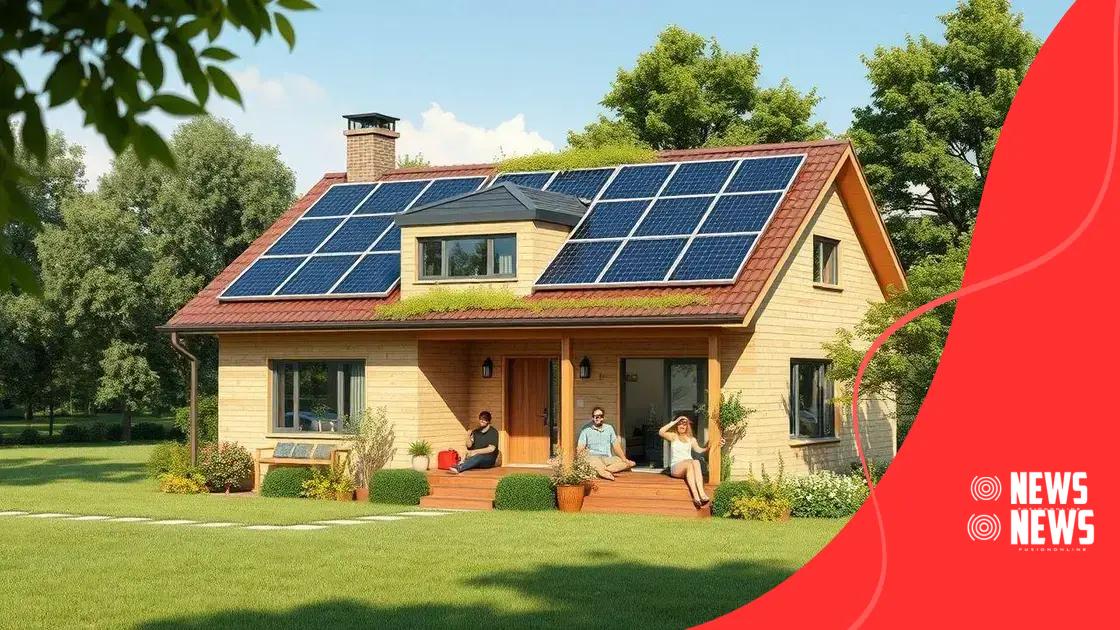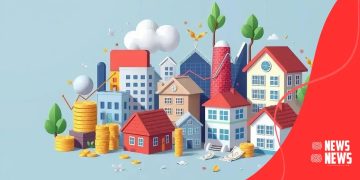Real estate market trends 2025: what to expect next
In 2025, real estate investment opportunities will focus on eco-friendly properties, emerging markets, and the impact of remote work, creating demand for larger homes in suburban areas and highlighting the importance of technology in decision-making.
The real estate market trends 2025 set the stage for exciting changes in property investments. Have you wondered how shifting dynamics will affect buying and selling? Let’s dive into the key trends shaping the future.
Economic factors influencing the real estate market
The economic factors influencing the real estate market play a crucial role in shaping trends and dynamics we see today. Understanding these factors can help investors make informed decisions. Let’s explore the key elements that affect market behavior.
Interest Rates
One significant factor is the prevailing interest rates. Lower rates make borrowing cheaper, which can lead to increased demand for homes. When rates rise, it often discourages potential buyers from making purchases.
Economic Growth
The overall state of the economy directly impacts real estate. More jobs and income increase consumer confidence. People are more likely to invest in property when they feel secure in their finances.
- Increased job opportunities
- Higher disposable income
- Greater consumer confidence
On the other hand, during economic downturns, we often see a decrease in housing demand. When uncertainty looms, buyers tend to wait before investing in real estate, which can slow market growth.
Supply Chain Challenges
Another critical influence comes from supply chain issues, affecting construction costs and timelines. Limitations on materials can delay projects, leading to lower inventory in the market, which can drive prices up.
- Impact of material shortages
- Rising construction costs
- Longer timelines for development
Ultimately, navigating these economic factors requires staying informed and adaptable. The real estate market is responsive to changes, and understanding these currents can better position investors for success.
How remote work impacts housing demands
The impact of remote work on housing demands has been significant over the past few years. As more people shift to flexible work options, their housing preferences are changing. This new trend shapes various aspects of the real estate market, from location choices to property types.
Preference for Larger Spaces
Many remote workers are seeking larger homes that can accommodate home offices and other needs. A spare room is no longer just for guests; it has become essential for productivity. This shift drives demand for single-family homes with dedicated office spaces.
Relocation to Suburbs
As employees no longer need to commute daily to offices, many are moving further away from urban centers. The suburbs are becoming attractive due to lower costs and greater space. Living farther from work is less concerning when commuting is no longer a daily requirement.
- Increased demand for suburban homes
- More family-oriented neighborhoods
- Shift away from urban density
This migration influences pricing as the demand in suburban areas rises. Additionally, the amenities coveted by remote workers are evolving. Buyers are looking for homes near parks, schools, and quiet neighborhoods, all of which enhance quality of life outside of work.
Technological Needs
Another significant aspect is the need for homes equipped with technology. High-speed internet access has become a priority for many buyers. When considering a new home, potential buyers often assess the internet availability and connection reliability.
- Homes with smart technologies
- Built-in workspaces
- Reliable internet connections
As the landscape of remote work continues to evolve, so too will the factors influencing housing demands. Understanding these trends can help investors and buyers make better choices in a changing market.
The rise of eco-friendly properties

The rise of eco-friendly properties is a significant trend in today’s real estate market. More buyers are seeking homes that minimize environmental impact and promote sustainable living. This shift is not just a passing fad; it reflects a growing awareness of global environmental issues.
Benefits of Eco-Friendly Homes
One major reason for the increase in demand for these properties is their numerous benefits. Eco-friendly homes often feature energy-efficient appliances and materials… which can lower utility costs. Buyers find value in homes that help them save money and reduce their carbon footprint.
Popular Eco-Friendly Features
Many eco-conscious buyers are interested in specific features that make homes more sustainable. These include:
- Solar panels to harness renewable energy
- Energy-efficient windows to enhance insulation
- Water-saving fixtures to reduce consumption
- Green roofs that promote biodiversity
These attributes not only appeal to the environmentally conscious but also often increase a property’s value. As awareness grows, more developers are incorporating these features into new constructions.
Additionally, communities are also becoming more focused on sustainability. Neighborhoods that prioritize parks, public transportation, and green spaces attract buyers looking for an eco-friendly lifestyle. People want to live in areas that reflect their values and commitment to the environment.
The Future of Eco-Friendly Real Estate
As technology advances, we can expect more innovations in eco-friendly construction. Smart home technology will play a vital role in energy management and efficiency, making sustainable living more accessible.
- Integration of smart energy systems
- Use of sustainable materials like bamboo
- Home automation for energy management
Understanding the rise of eco-friendly properties is crucial for anyone involved in real estate. This trend not only benefits the environment but also offers promising investment opportunities.
Urban vs. suburban housing trends
The urban vs. suburban housing trends have seen notable changes recently. Many buyers are now weighing their options between city living and suburban life. This shift is significantly influenced by lifestyle preferences and evolving work arrangements.
Urban Living
Urban areas have traditionally been popular due to their accessibility to amenities, work opportunities, and entertainment. City dwellers enjoy having restaurants, shops, and cultural attractions within walking distance. However, the cost of living in these areas is often high, leading many to reconsider their choices.
Suburban Appeal
On the other hand, suburban areas are becoming increasingly attractive. Families and individuals are drawn to the spaciousness and often lower housing costs in suburbs. Here, they can find larger homes with yards, making it ideal for families with children or pets.
- More affordable housing options
- Access to parks and recreational spaces
- Quieter, slower-paced environments
The trend toward remote work has also played a critical role in this shift. With more people working from home, the need for proximity to urban centers has diminished. Many individuals are no longer tied to a specific location for their jobs, allowing them to seek out homes that fit their lifestyle preferences better.
Market Dynamics
As demand changes, real estate markets are adjusting accordingly. Urban areas are seeing a slight decline in prices due to reduced demand, while suburban areas may experience price increases as buyers flock to these regions. This shift in housing trends reflects broader lifestyle choices and changing priorities, emphasizing space, comfort, and community over urban conveniences.
- Investors are looking at suburbs for growth potential
- Urban properties may face longer times on the market
- Diverse housing options in suburban developments
Investment opportunities in 2025
The investment opportunities in 2025 present a landscape filled with potential for both seasoned investors and newcomers. As the real estate market evolves, understanding where to put your money can lead to significant returns.
Emerging Markets
One significant trend is the rise of emerging markets. These areas are often experiencing rapid growth due to urbanization and economic development. Investors can find new opportunities in these locations as demand for housing increases.
Technology-Driven Investments
Additionally, technology continues to reshape the real estate industry. The use of proptech is on the rise, making investment processes more efficient. Investors might consider platforms that use data analytics to predict trends and assess property values accurately.
- Invest in properties using AI-driven assessments
- Explore crowdfunding platforms for diverse investments
- Consider smart home technology as a value-add
Furthermore, there is an increasing focus on sustainable properties. As the demand for eco-friendly buildings rises, investing in green real estate can yield long-term benefits. Properties that embrace sustainable practices often attract buyers willing to pay a premium for environmental responsibility.
Rental Market Growth
The rental market is also adjusting. With more people opting to rent rather than buy, the demand for rental properties is stronger than ever. Investors should consider areas with stable job growth and amenities that attract renters.
- Identify rental hotspots in growing communities
- Focus on properties that appeal to young professionals
- Explore multi-family units for steady cash flow
Understanding these trends can equip investors with the knowledge needed to navigate the market confidently. As we approach 2025, keeping an eye on these opportunities will be key to maximizing potential returns.
In conclusion, the real estate market is changing rapidly as we head towards 2025. Understanding these shifts can help you make informed decisions, whether you want to invest, buy, or rent. The demand for eco-friendly properties, the rise of remote work, and the preferences between urban and suburban living are all important trends to watch. By keeping an eye on these developments, you can seize opportunities and stay ahead in the market. Here are some key takeaways:
FAQ – Frequently Asked Questions about Real Estate Trends in 2025
What are the key factors influencing the real estate market in 2025?
Key factors include economic growth, interest rates, remote work trends, and consumer preferences for eco-friendly properties.
How does remote work impact housing demands?
Remote work increases demand for larger homes in suburban areas as people seek more space for home offices.
What types of properties are expected to rise in demand?
Eco-friendly properties and homes in emerging markets are expected to see significant demand due to buyer interest and sustainability trends.
Why is technology important for real estate investments?
Technology enhances decision-making through data analytics, improves property management, and increases efficiency in transactions.





